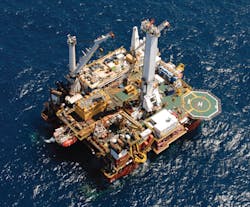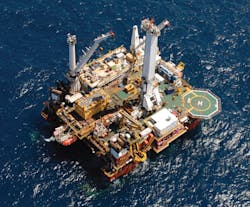Plans are progressing for the next stage of methane hydrate scientific drilling by the University of Texas at Austin (UT) and its partners on the US Outer Continental Shelf (OCS). Researchers hit a momentary snag regarding research vessels.
The International Ocean Discovery Program (IODP) selected the UT project for the IODP Expedition 386, planned for the northern Gulf of Mexico during January-March 2020 using the JOIDES Resolution research vessel.
IODP planned to log, core, and perform downhole experiments in the Orca and Terrebonne basins. IODP planned a 56-day testing program. However, researchers since determined the JOIDES Resolution does not meet US regulatory requirements for a mobile offshore drilling unit (MODU).
The Helix Q4000 semisubmersible. Photo from OGJ archives.
The MODU 1989 Standards, required by the US Coast Guard and the Bureau of Safety and Environmental Enforcement, establishes criteria for drilling and stratigraphic testing in boreholes deeper than 500 ft below the sea floor.
But UT, its partners, and the US Bureau of Ocean Energy Management remain committed to the scientific goals, said Peter B. Flemings, Jackson School of Geosciences professor on UT’s Austin campus.
“Furthermore, the IODP has not cancelled the expedition,” Flemings said. “Rather, they have referred it to the European Science Operator (ESO) and strongly recommended that this be pursued.”
UT now is talking with the IODP about executing the expedition as a Mission Specific Platform with ESO as the operator responsible for the expedition.
Flemings told OGJ that he “hopes to have a clear path forward by September or October.”
BOEM serves in a scientific advisory role to UT’s OCS hydrate research. Partners are IODP, US Department of Energy-National Energy Technology Laboratory, Ohio State University, Lamont-Doherty Earth Observatory, US Geological Survey, University of Washington, Oregon State University, and University of New Hampshire.
The drilling expedition also plans to study the in situ thermodynamic state and physical properties of hydrate-bearing sediments and their response to perturbation.
Research history
Gas hydrates are an emerging natural gas resource although geological uncertainties and technical difficulties have yet to be resolved.
BOEM was a founding member of a gulf gas hydrate joint industry project (JIP) that was financed by DOE and operated by Chevron Corp. The Leg 1 drilling program, starting in 2005, discovered gas hydrates in shale reservoirs in Keathley Canyon and Atwater Valley.
The Leg 2 drilling program found gas hydrates in high saturations in sand reservoirs on the Walker Ridge and Green Canyon areas. The JIP ended after Leg 2.
DOE continues to finance gas hydrate drilling on the OCS. UT now leads the research program. In May 2017, the UT project used the Helix Q4000, a semisubmersible, to drill two wells in the deepwater gulf at the GC 955 site.
Helix Energy Solutions owns the Helix Q4000, built for well intervention and construction in water depths to 10,000 ft. The Q4000 is used for subsea completion, decommissioning, and coiled tubing deployment.
Research crews collected 12 pressure cores at the GC 955-H005 well, but the bottom-hole assembly design prevented any geophysical logging.
The final six coring runs recovered 31.8 ft of sediment with 17.2 ft collected at or above hydrate stability pressure. Scientists reported good recovery of samples under pressure in the gas hydrate-bearing layers.
Scientists moved the 20 best core sections to an onshore, temporary core-handling center in Port Fourchon, La. The cores were processed and transferred under pressure to a UT cold storage laboratory.
About the Author
Paula Dittrick
Senior Staff Writer
Paula Dittrick has covered oil and gas from Houston for more than 20 years. Starting in May 2007, she developed a health, safety, and environment beat for Oil & Gas Journal. Dittrick is familiar with the industry’s financial aspects. She also monitors issues associated with carbon sequestration and renewable energy.
Dittrick joined OGJ in February 2001. Previously, she worked for Dow Jones and United Press International. She began writing about oil and gas as UPI’s West Texas bureau chief during the 1980s. She earned a Bachelor’s of Science degree in journalism from the University of Nebraska in 1974.


